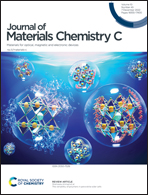Polyamide-imide/polyimide alloy with enhanced energy density and efficiency†
Abstract
Polymers with both high dielectric breakdown strength and high dielectric constant are vital for a large number of applications. However, most polymer or polymer composites suffer from the problem of deteriorated breakdown strength caused either by undesired submicron voids during film processing or the addition of high dielectric constant filler. In this work, we present a facile blending strategy to fabricate polyamide-imide (PAI)/polyimide (PI) alloy. The strong interchain hydrogen bonds and electrostatic force of the PAI/PI alloy increase chain packing density and decrease possible corresponding imperfect points. The intermolecular forces are simulated and calculated via Materials Studio. It is found that the PAI/PI alloy with 50 wt% PAI possesses the strongest intermolecular forces, which is consistent with the experimental results. The PAI/PI alloy with 50 wt% PAI exhibits enhanced dielectric properties, such as 54.3% improvement in breakdown strength, 68.8% enhancement in dielectric constant and suppressed dielectric loss compared with pristine PI, leading to a high discharged energy density of 5.84 J cm−3 with an efficiency of 91.8% at 545 MV m−1. The excellent performance of the PAI/PI alloy can be attributed to the polar groups in PAI that promote the dielectric constant, strong hydrogen bonds and electrostatic force between the molecule chains in the blend that contribute to the greatly enhanced breakdown strength. This novel molecular engineering strategy is an effective way to fabricate high-performance dielectric polymers for film capacitor applications.



 Please wait while we load your content...
Please wait while we load your content...